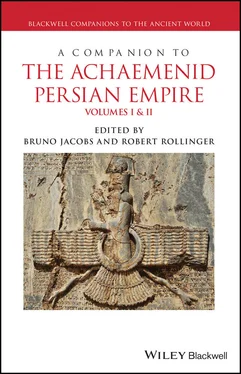King Išpuini, “Lord of the city of 瞈ušpa,” achieved the final unification into one state of all the peoples settled over a wide territory of the Armenian highland, and also the annexation of the territory east of the Zagros mountains, the modern territory of Iranian Azerbaijan. We have no idea of the ethnic composition of the new state. All we can say for the Urartians, who were the driving force and center of the kingdom, is that according to the language of the royal inscriptions, they were neither Semites nor Indo‐Europeans. They were related only to the Hurrians who are attested from the end of the third to the beginning of the first millennium BCE in many regions of the Near East (Salvini 2000). However, the element binding the peoples unified in the Urartian kingdom was not only the use of the Urartian language in progressive substitution of the Assyrian one.
The Religion as “ Instrumentum Regni ”
Išpuini was the first Urartian king who knew how to exploit the religious element, which would become the basis of the state. There are two major written documents testifying to this policy. The first is the Kelišin stela (CTU A 3‐11), erected on the 3000 m high pass of the Zagros range, which deals with a political pilgrimage by Išpuini and his son Minua around 810 BCE to the temple of the god  aldi in Muṣaṣir. The Kelišin stela shows that the city‐state and international sanctuary of Muṣaṣir, situated in today's Iraqi Kurdistan, was controlled by the Urartians around 820–810 BCE, the period in which we must date the numerous joint inscriptions of Išpuini and Minua.
aldi in Muṣaṣir. The Kelišin stela shows that the city‐state and international sanctuary of Muṣaṣir, situated in today's Iraqi Kurdistan, was controlled by the Urartians around 820–810 BCE, the period in which we must date the numerous joint inscriptions of Išpuini and Minua.
The most meaningful evidence of Išpuini's policy is the open air sanctuary of Meher Kapısı near Van, with its rock inscription (CTU A 3‐1) fixing the whole Urartian pantheon headed by the supreme triad: the god  aldi, the weather god Teišeba (cf. the Hurrian Tešub), and the sun god Šiuini. It is an inventory of animal sacrifices offered to a long list of gods and goddesses, in connection with the seasonal labors of agriculture. Such a monument and its ideology were the consequence of the conquest and the establishment of a protectorate over the city‐state of Muṣaṣir and its international sanctuary of god
aldi, the weather god Teišeba (cf. the Hurrian Tešub), and the sun god Šiuini. It is an inventory of animal sacrifices offered to a long list of gods and goddesses, in connection with the seasonal labors of agriculture. Such a monument and its ideology were the consequence of the conquest and the establishment of a protectorate over the city‐state of Muṣaṣir and its international sanctuary of god  aldi. Išpuini, introducing the cult of
aldi. Išpuini, introducing the cult of  aldi in his realm, must be considered as the second founder of the Urartian state on a theocratic basis. From that time the Urartian kings stood under the “protection” (Urartian ušmaše , Assyrian ṣillu ) of their national god
aldi in his realm, must be considered as the second founder of the Urartian state on a theocratic basis. From that time the Urartian kings stood under the “protection” (Urartian ušmaše , Assyrian ṣillu ) of their national god  aldi. 1 They gave, in fact, enormous importance to
aldi. 1 They gave, in fact, enormous importance to  aldi's temple at Muṣaṣir, at least from the time of Išpuini up to Rusa I, when the final clash with the Assyrians took place, namely in 714 BCE with the Eighth Campaign of Sargon and the sack of Muṣaṣir (Thureau‐Dangin 1912).
aldi's temple at Muṣaṣir, at least from the time of Išpuini up to Rusa I, when the final clash with the Assyrians took place, namely in 714 BCE with the Eighth Campaign of Sargon and the sack of Muṣaṣir (Thureau‐Dangin 1912).
During the time of the co‐regency between Išpuini and Minua (c. 820–810 BCE) the most important military expeditions were directed eastward, beyond the Zagros range. The Karagündüz stela (CTU A 3‐9) records a single campaign directed against Mešta and three other cities, and the land of Paršua, an early mention of Persian tribes. The name of the city of Mešta is the link with the plain between Nagadeh and Miyandoab, south of Lake Urmia in Iranian Azerbaijan. In fact, it is mentioned also in the later inscription of Minua in Taštepe (CTU A 5‐10). Thus I suggested the identification of Mešta with Tappeh Hasanlu (in Pecorella and Salvini 1984: pp. 19–21) because it was the main city in that region at the end of the ninth century BCE (Salvini 1993). This seems to fit well with the burned level of Hasanlu IV and with its radio‐carbon dating (Muscarella 2012). However, one cannot exclude an alternative identification with another site, for example Nagadeh, in the same region, but this would not change the matter. Even Paršua, or part of it, should be located in this period not far from the southern shore of Lake Urmia. But this contrasts with the location of Paršua (RlA s.v.) further to the south, even on the basis of the Assyrian texts of the ninth century BCE itself (Salvini 2009).
The Urartian presence at Hasanlu, in level IIIb, has to be stressed particularly: the so‐called “Fortification Wall II” was built by the Urartians around the eighth century BCE (Dyson 1989: pp. 6–7). Moreover, with regard to the northwestern shores of Lake Urmia, we must add the presence of the Urartians in the valley of Salmas, as is attested by level III at Haftavan Tappeh (Burney 1971).
The Citadel of Van Kalesi and Its Historical Monuments
The acropolis of the Urartian capital lies on the central section of the rocky crest ( Figure 26.2). Situated on the highest point of the rock (approximately 90 m), its perimeter follows the line of the rock, as may clearly be noted from the south side.
The northern wall of the citadel reveals different building phases. The great size and quality of the squared‐off stone blocks at the base of the wall show similarities with the “Sardursburg” and must date back to the time of Sarduri I, although we do not have a foundation inscription to confirm this.
On the southern slope of Van Kalesi are the chambers of Horhor, the main monument left to us by Argišti I, son of Minua (André‐Salvini and M. Salvini 1992, with previous bibliography). The long inscription of his annals with the deeds of the king, decorating the entrance of this rock mausoleum, is the most extensive document in Urartian cuneiform epigraphy (CTU A 8‐3). Not only the conquests in Transcaucasia and in northern Iran are celebrated here but even the foundation of two important towns in Armenia, namely Erebuni and Argišti  inili. Many rock tombs (beside some other huge chamber complexes of unknown purpose) are still visible on the south slope of Van Kalesi, which can be linked with the later Achaemenid rock tombs (Calmeyer 1975). An important architectural feature which connects the two civilizations is the Urartian tower temple (high, square with edge buttresses, and with one single cella), which is perhaps the precedent of the Kaba‐ye Zardušt (Stronach 1967, 2012).
inili. Many rock tombs (beside some other huge chamber complexes of unknown purpose) are still visible on the south slope of Van Kalesi, which can be linked with the later Achaemenid rock tombs (Calmeyer 1975). An important architectural feature which connects the two civilizations is the Urartian tower temple (high, square with edge buttresses, and with one single cella), which is perhaps the precedent of the Kaba‐ye Zardušt (Stronach 1967, 2012).
The Annals of Sarduri II in Hazine Kapisi (CTU A 9‐1‐3)
On the northern slope of the eastern sector of Van Rock the Russian expedition of 1916 unearthed the famous text of the Annals of Sarduri II, son of Argišti (Marr and Orbeli 1922). The first successful military expeditions of this king, who reigned between 755 and c. 730 BCE, are summarized at the beginning of his annals: the conquest of the lands Ueliku  i in Armenia, Tuli
i in Armenia, Tuli  u in Transcaucasia, and, most importantly, a victory over the Assyrian king Aššurnirari V (754–746 BC) in the first years of his reign (Salvini 1995: 66 ff). Following his father, Sarduri made expeditions against the countries of Mana (Assyrian Mannea: RlA s.v.), Babilu, and Baruata in Iran, and Etiuni and Erikua
u in Transcaucasia, and, most importantly, a victory over the Assyrian king Aššurnirari V (754–746 BC) in the first years of his reign (Salvini 1995: 66 ff). Following his father, Sarduri made expeditions against the countries of Mana (Assyrian Mannea: RlA s.v.), Babilu, and Baruata in Iran, and Etiuni and Erikua  i in Armenia, with the conquest of the southern shore of Lake Sevan. Furthermore, he reached the northern land of Qul
i in Armenia, with the conquest of the southern shore of Lake Sevan. Furthermore, he reached the northern land of Qul  a, in which we identify the oldest record of classical Colchis.
a, in which we identify the oldest record of classical Colchis.
Читать дальше

 aldi in Muṣaṣir. The Kelišin stela shows that the city‐state and international sanctuary of Muṣaṣir, situated in today's Iraqi Kurdistan, was controlled by the Urartians around 820–810 BCE, the period in which we must date the numerous joint inscriptions of Išpuini and Minua.
aldi in Muṣaṣir. The Kelišin stela shows that the city‐state and international sanctuary of Muṣaṣir, situated in today's Iraqi Kurdistan, was controlled by the Urartians around 820–810 BCE, the period in which we must date the numerous joint inscriptions of Išpuini and Minua. inili. Many rock tombs (beside some other huge chamber complexes of unknown purpose) are still visible on the south slope of Van Kalesi, which can be linked with the later Achaemenid rock tombs (Calmeyer 1975). An important architectural feature which connects the two civilizations is the Urartian tower temple (high, square with edge buttresses, and with one single cella), which is perhaps the precedent of the Kaba‐ye Zardušt (Stronach 1967, 2012).
inili. Many rock tombs (beside some other huge chamber complexes of unknown purpose) are still visible on the south slope of Van Kalesi, which can be linked with the later Achaemenid rock tombs (Calmeyer 1975). An important architectural feature which connects the two civilizations is the Urartian tower temple (high, square with edge buttresses, and with one single cella), which is perhaps the precedent of the Kaba‐ye Zardušt (Stronach 1967, 2012).










